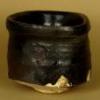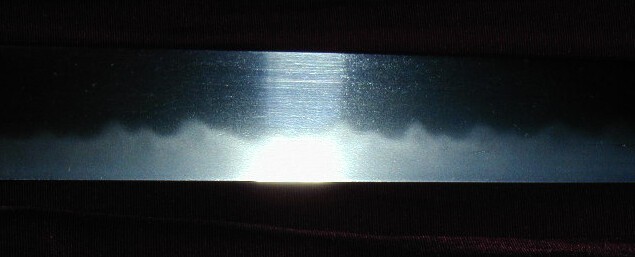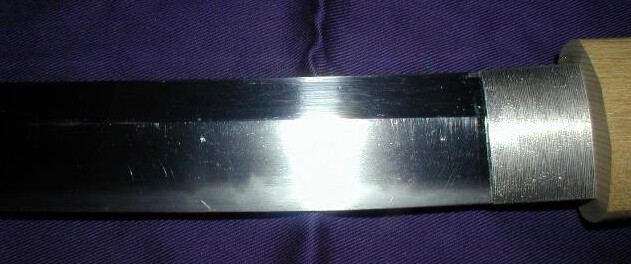-
Posts
6,786 -
Joined
-
Days Won
10
Content Type
Profiles
Forums
Events
Store
Downloads
Gallery
Everything posted by cabowen
-
Depending on what was cut, not all blades crack when used. I think it can be argued that for many that do, versus those that don't, it is indeed a sign of poor(er) workmanship....This is the raison d'etre of the cutting tests performed in Shinto and Shinshinto, and arguably the Rikugun Jumei Tosho program. A Kotetsu blade was said to have cleaved a stone lantern and thus a reputation was born....
-
Some might argue that a hagire is the ultimate in poor workmanship....
-
Generally speaking, the tolerance for flaws is usually relative to the age of the blade and the type of flaw. Some flaws, those that have a detrimental effect on function, are bad no matter when the blade was made. Others, mostly cosmetic, can be ignored on older blades but less so on newer blades. Of course nearly any flaw will cause a decrease in market price. Personally, since I collect mainly Meiji, Taisho, and early Showa Tokyo work, I will tolerate extremely little as far as flaws are concerned. There are usually enough works still surviving by smiths of this period that eventually one can find a flawless example. I think we will find that tolerance of flaws is tied to our sword "value system"- as I asked before, are they art or artifacts? People who value the history and view swords as artifacts tend to have a higher tolerance for flaws, some even value them as "part of the sword's history". Others, who collect swords as art, will have less tolerance for flaws.
-
I would send to shinsa before polish. It is in good enough condition as is for a judgment. If it is judged to be something exceptional, then the money and time for a new polish would be a worthy investment. I have seen too many times someone all gung ho on a blade spend $4000-$5000 on a new polish then shinsa, only to have it fail or get a less than hoped for attribution.
-
後代の毛抜形太刀 柄前 later kenuki shape tachi tsuka mae 毛抜形太刀柄 競馬太刀柄 kenuki shape tachi tsuka keiba tachi tsuka
-
It says Sadaroku....nothing new there... As I said, it was probably made as a special order as this kokuin is unusual in his work.... Thanks for taking the time to post this...
-
Seki smith and Rikugun Jumei Tosho. Every dog has his day, as they say. Even lower ranked smiths sometimes got everything right and made something better than their average work... Kanetsune was also a Seki smith. His family name was Nishimura....
-
I will certainly post info and updates here as they become available.... Not sure yet if I will be bringing over craftsman or not. Most of those I work with are getting old and it is getting harder for them to make the trip....
-
Very nice. Please do get it to a shinsa. We will host one in Minneapolis in Oct., 2011. There will be a service to submit blades for those who are unable to attend. Details will be posted on this board....
-
If you could post a closeup of the kokuin, perhaps I could tell you more.... Also, to clarify my earlier comments regarding jigane and hamon, I should add that extremely tight (締まる) nioi guchi are, in general, not considered "top of the road".
-

Help with the mei on a little tsuba: Bushu-Ito or Choshu
cabowen replied to Curran's topic in Translation Assistance
That was my second guess.... -

Help with the mei on a little tsuba: Bushu-Ito or Choshu
cabowen replied to Curran's topic in Translation Assistance
from an earlier post by Morita san, it seems that KI can be written 記 or 紀 shu is 州 kishu is normally 紀州 but in line with what Morita san said earlier, perhaps 記州 is also acceptable. The drawing you made of the second kanji might be shu 州 with a little imagination, assuming there are three vertical strokes as you suggest there may be... Of course without seeing the actual signature this is all just shooting in the dark.... -
山城守国重 yamashiro no kami kunishige
-

Help with the mei on a little tsuba: Bushu-Ito or Choshu
cabowen replied to Curran's topic in Translation Assistance
紀州 kishu perhaps.... -
I have seen a dozen or more of his blades and most of them have been in suguba, which was also what his teacher favored....
-
look into yamato....
-
Kakihan is usually carved, koku'in is stamped.... Polish maybe has that look due to the lighting/photo technique???? Notice the dense, uniform hada, the thick nie lining the habuchi in these "top of the road" examples...(pardon the poor photos). A blade by Kato Sukekuni : Here is another by Kasama Shigetsugu (his work, not student work): And another by Kato Masayoshi:
-
He was a student of Amada Sadayoshi, father of the Ningen Kokuho Amada Akitsugu. Was a rikigun jumei tosho. Middle of the road smith....Mei is nicely cut; possibly a special order blade as I see no star stamp and there appears to be a kokuin, not seen on his usual work. Polish looks buffed and/or acid treated....
-
Hamon looks more Bizen than Mino, at least what I can see of it....masame in the shinogi-ji points more to shinto than koto.
-
Never would have guessed!
-
It is a commemorative for the 30th Hiroshima City's Youth Kendo Tournament The left side says Hiroshima Heiwa (peace) L.C. --- no idea what the L.C. stands for....
-
It is easier to lacquer the inside of the hi than to polish it. It is most often seen on yari and naginata, and lesser quality ones in general. From what I have been told by Japanese polishers, it was a cost and time saving measure. Additionally, it has been used to hide flaws on occasion....
-
As someone mentioned, steel needs oxygen to oxidize. Here is what I do (and it is what some togi I know in Japan do too): Coat the blade with a moisture displacing oil like Sheath. Wrap the blade tightly in saran wrap, tape the ends. Lay flat. The oil and plastic make it difficult for oxygen to get to the blade. For nakago, wrap the blade as above but leave the nakago unwrapped. Stand the blade up with the nakago immersed in an oil bath. Mineral oil or fine machine oil works fine. Leave it like this for a few weeks, Then take it out and rub it down well with a soft cloth. The red rust should start to come off. Repeat the process as necessary. Eventually the red rust will be gone and then by keeping the nakago lightly oiled, the natural oxidation will start.









